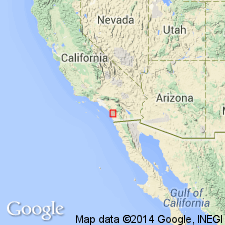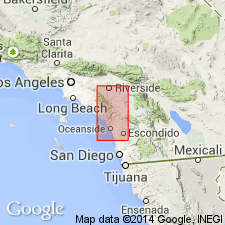
- Usage in publication:
-
- San Marcos gabbro
- Modifications:
-
- Named
- Dominant lithology:
-
- Gabbro
- AAPG geologic province:
-
- Peninsular Ranges province
Summary:
Named for occurrence in greater part of San Marcos Mountains, San Luis Rey 30' quad, San Diego Co, CA. [Name San Marcos Mountain gabbro first used by Hurlbut (1935) who credited name to F.S. Miller (1934, PhD thesis)]. Forty gabbro bodies occupy 60 sq mi in San Luis Rey quad. Gabbros apparently identical to San Marcos occur in Cuyamaca region and La Jolla and San Jacinto quads. San Marcos gabbro includes a wide range in composition and texture within gabbro family, most abundant of which is medium-grained dark-gray norite. Intrudes Triassic metamorphosed rocks. Map legend on geologic sketch map of San Luis Rey quad shows age as Jurassic.
Source: GNU records (USGS DDS-6; Menlo GNULEX).

- Usage in publication:
-
- San Marcos gabbro*
- Modifications:
-
- Adopted
- Age modified
- Overview
- AAPG geologic province:
-
- Peninsular Ranges province
Summary:
San Marcos gabbro of Miller (1937) is adopted. Includes rocks in Elsinore 30' quad called Virginia quartz-hypersthene norite by Dudley (1935). San Marcos occurs in San Luis Rey, Elsinore, and Corona 30' quads in about 100 mappable bodies, largest of which is southeast of Lake Elsinore (25 sq mi area); one body in San Marcos Mountains underlies 11 sq mi. In Julian district unit has been called Cuyamaca basic intrusive by Donnelly (1934). San Marcos intrudes Bedford Canyon formation (new) and Santiago Peak volcanics (new). Is older than Green Valley tonalite (new) and Lakeview Mountain tonalite (new). In Ramona quad San Marcos intrudes Stonewall granodiorite (Merriam, 1946). Detailed petrographic description and chemical analysis included. Map legend shows age as Cretaceous.
Source: GNU records (USGS DDS-6; Menlo GNULEX).
For more information, please contact Nancy Stamm, Geologic Names Committee Secretary.
Asterisk (*) indicates published by U.S. Geological Survey authors.
"No current usage" (†) implies that a name has been abandoned or has fallen into disuse. Former usage and, if known, replacement name given in parentheses ( ).
Slash (/) indicates name conflicts with nomenclatural guidelines (CSN, 1933; ACSN, 1961, 1970; NACSN, 1983, 2005, 2021). May be explained within brackets ([ ]).

